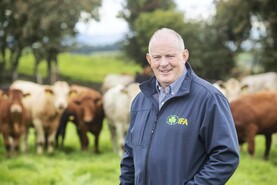Last year was the first time all cattle were finished on the farm. After trying many different systems over the years, we settled on the under 16-month bull option.
In a low margin enterprise such as beef, it's not possible for both a suckler producer or a beef finisher to both do well financially. Someone has to lose out. Someone always leaves the mart disappointed and frustrated, the seller has done well while the purchaser feels ripped off or vice versa.
We'd had enough of that. You were rolling the dice each time you went to the mart.
For all the negativity surrounding processors, at least you have the price the beef will make at the various grades before you sell. It's up to yourself as a seller to take or leave that price.
Changing to producing under 16-month old bulls didn't require any change of facilities and allows for an increase stocking rates as they don't get a second season at grass, so cow numbers have held. Male/female ratio of calves determines the housing arrangements and this year there are three pens of seven and eight in the smaller bull group.
Feed
The bigger 21 bulls are on 69%DMD silage adlib as the bales proved more consistent than the 72%DMD bales and since the beginning of January have been on seven to eight kilos of a bull finishing nut. It has a ME of 11.58 and 17.4% protein. It has high protein as they are still young animals and need good bone development. The smaller eight are receiving under 4kg and have an ADG of 0.85kg/day. These are predominantly April calves.
Weights
The bulls got their final weighing before sale in April and May this week. They had been weighed monthly to keep track of performance and any slip ups. Average daily weight gain in the last month varied from 0.42kg to 2.03 with the average for all bulls at 1.3kg, with the bigger ones 21 averaging 1.47kg/day.
While it doesn't fit the pasture fed image, grass plays a big part in the system with the target to wean as close to 400kgs as possible. The 2014 profit monitor results justify our move, output in terms of sales and kilos of live weight sold have increased significantly while feed costs have increased over all variable costs have remained on par with other years.






 This is a subscriber-only article
This is a subscriber-only article












SHARING OPTIONS: